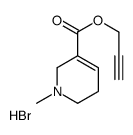ARECAIDINE PROPARGYL ESTER HYDROBROMIDE (APE)

ARECAIDINE PROPARGYL ESTER HYDROBROMIDE (APE) structure
|
Common Name | ARECAIDINE PROPARGYL ESTER HYDROBROMIDE (APE) | ||
|---|---|---|---|---|
| CAS Number | 116511-28-5 | Molecular Weight | 260.12800 | |
| Density | N/A | Boiling Point | 252.5ºC at 760mmHg | |
| Molecular Formula | C10H14BrNO2 | Melting Point | 179 °C | |
| MSDS | Chinese USA | Flash Point | 97.2ºC | |
|
Akt-activated endothelium constitutes the niche for residual disease and resistance to bevacizumab in ovarian cancer.
Mol. Cancer Ther. 13(12) , 3123-36, (2014) Ovarian cancer is the second leading cause of cancer-related death in women worldwide. Despite optimal cytoreduction and adequate adjuvant therapies, initial tumor response is often followed by relapse suggesting the existence of a tumor niche. Targeted thera... |
|
|
Perilipin-related protein regulates lipid metabolism in C. elegans.
PeerJ 3 , e1213, (2015) Perilipins are lipid droplet surface proteins that contribute to fat metabolism by controlling the access of lipids to lipolytic enzymes. Perilipins have been identified in organisms as diverse as metazoa, fungi, and amoebas but strikingly not in nematodes. H... |
|
|
A Fluorescent Probe to Measure DNA Damage and Repair.
PLoS ONE 10 , e0131330, (2015) DNA damage and repair is a fundamental process that plays an important role in cancer treatment. Base excision repair (BER) is a major repair pathway that often leads to drug resistance in DNA-targeted cancer chemotherapy. In order to measure BER, we have dev... |
|
|
Effect of aging on muscle mitochondrial substrate utilization in humans.
Proc. Natl. Acad. Sci. U. S. A. 112 , 11330-4, (2015) Previous studies have implicated age-associated reductions in mitochondrial oxidative phosphorylation activity in skeletal muscle as a predisposing factor for intramyocellular lipid (IMCL) accumulation and muscle insulin resistance (IR) in the elderly. To fur... |
|
|
Adipose triglyceride lipase is involved in the mobilization of triglyceride and retinoid stores of hepatic stellate cells.
Biochim. Biophys. Acta 1851 , 937-45, (2015) Hepatic stellate cells (HSCs) store triglycerides (TGs) and retinyl ester (RE) in cytosolic lipid droplets. RE stores are degraded following retinoid starvation or in response to pathogenic stimuli resulting in HSC activation. At present, the major enzymes ca... |
|
|
Apurinic/apyrimidinic endonuclease 1 on aging-associated deteriorations in rat kidneys.
Free Radic. Res. 49(1) , 95-101, (2014) We have reported a possible involvement of apurinic/apyrimidinic endonuclease 1 (APE1), one of the DNA repair pathways, in various nephropathy models and found that there is a close connection between APE1 and p53-dependent apoptosis. Therefore, we investigat... |
|
|
Investigation of protein distribution in solid lipid particles and its impact on protein release using coherent anti-Stokes Raman scattering microscopy.
J. Control. Release 197 , 111-20, (2014) The aim of this study was to gain new insights into protein distribution in solid lipid microparticles (SLMs) and subsequent release mechanisms using a novel label-free chemical imaging method, coherent anti-Stokes Raman scattering (CARS) microscopy. Lysozyme... |
|
|
A novel therapeutic strategy to rescue the immune effector function of proteolytically inactivated cancer therapeutic antibodies.
Mol. Cancer Ther. 14 , 681-91, (2015) Primary and acquired resistance to anticancer antibody immunotherapies presents significant clinical challenges. Here, we demonstrate that proteolytic inactivation of cancer-targeting antibodies is an unappreciated contributor to cancer immune evasion, and th... |
|
|
Aliphatic and heterocyclic analogues of arecaidine propargyl ester. Structure-activity relationships of mono- and bivalent ligands at muscarinic M1 (M4), M2 and M3 receptor subtypes.
Arzneimittelforschung 45 , 449, (1995) The pharmacological profiles of tertiary and quaternary monovalent (1b-6b) and bivalent ligands (7a-12b), closely related to arecaidine propargyl ester (CAS 35516-99-5, APE, 1a), were evaluated at muscarinic receptors in rat superior cervical ganglia (M1), ra... |
|
|
Quantitative colorimetric and gas chromatographic determination of arecaidine propargyl ester.
J. Chromatogr. B. Biomed. Sci. Appl. 692 , 345-350, (1997) Arecaidine propargyl ester (APE) is a potent muscarinic agonist often used in pharmacological studies. To date, no sensitive quantitative analytical method for APE has been published. In this study, two methods for the quantitative determination of APE are co... |